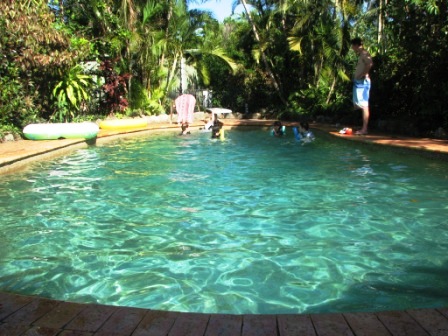Fighting Fair in Africa with Sleepy Lush Products.

Spelling: The plane trip home from Brisbane afforded me some time to reflect on spelling words that Boy needs to know. This term we are spending time getting to know our community. Whereas Boy knows the names of towns surrounding us he does not know how to spell them. Hence our list of ten contains: Mungalli Falls, Cairns, Brisbane, Townsville, Port Douglas, Great Barrier Reef, Mossman Gorge, Lakeland Downs, Cooktown, and Edge Hill. Boy has visited all of these places but does he know how to spell them in order to Google them for additional information??? Well, he got six out of ten with our first spelling test this morning and did he carry on about the list being greater than 10 words. He reasoned that Great Barrier Reef should count as three words for example. If I could have sent him to the detention room I would have!!!!! When I started on about proper nouns needing capital letters I knew I had gone too far. I'm surprised I didn't have the Lush massage bar thrown at me!
Geography: Gillian’s Africa challenge beckoned us. I printed out the map and Boy and I studied the names of the many African countries. I was able to tell Boy the odd anecdotal story about some of the African countries and impart tidbits of knowledge regarding Boy favored movies set in African countries. Boy now wants to visit the Seychelles and find pirate treasure. The Seychelles has been on my to visit immediately list for the last 20 years (not for treasure hunting). Unfortunately, “visit immediately” has always been superseded by “immediate responsibility” in paying bills and caring for a large family. Perhaps Boy's weekly spelling account (we pay him 20 cents per correct spelling word on every Friday's spelling test) will be able to shout me a trip because the cost of our impending wedding is suggestive of a frugal and grounded lifestyle for the next year!!!!
Monday is Youth Group day where Boy tackles issues of anger management, self-esteem and group social skills (falls under Health and Physical Education). Last week they covered the rules of fair fighting:
- Be willing to fix the problem,
- Say what the problem is for you,
- Listen to what the problem is for them,
- Attack the problem, not the person,
- Look for answers so everyone gets what they need.
Fouls to fighting fair include:
- Name calling,
- Put downs,
- Sneering or blaming,
- Threats or hitting,
- Bring up the past,
- Making excuses,
- Not listening,
- Getting even.
Do you include any emotional intelligence in your home school learning?





3 comments:
I use this to raise my children:
The Problem. I know I wrote it, but it really does work. Let me know if you try it.
Hi Stu
thanks for visiting and commenting. I can actually use your method with my uni students (I teach some social work subjects). While I always teach that the person is not the problem, the problem is the problem, you have captured it in a very easy way to understand and give practical examples for real people. I like that.
Well done to you.
We use several methods for problem solving in emotional situations that we learned when N. did group therapy at a place called KidPower.
The therapy itself was cool--it was for kids with AS. There were four-five kids in N.s group ranging in age from two years older than N. to a year younger.
One plan we still use often is called the SPACE plan.
1. What was the Situation?
2. Who were the People involved?
3. What were their Actions? What were your Actions?
4. What were the Consequences?
5. If you did this differently, what would you Expect to do next time in order to make it work out better?
Post a Comment